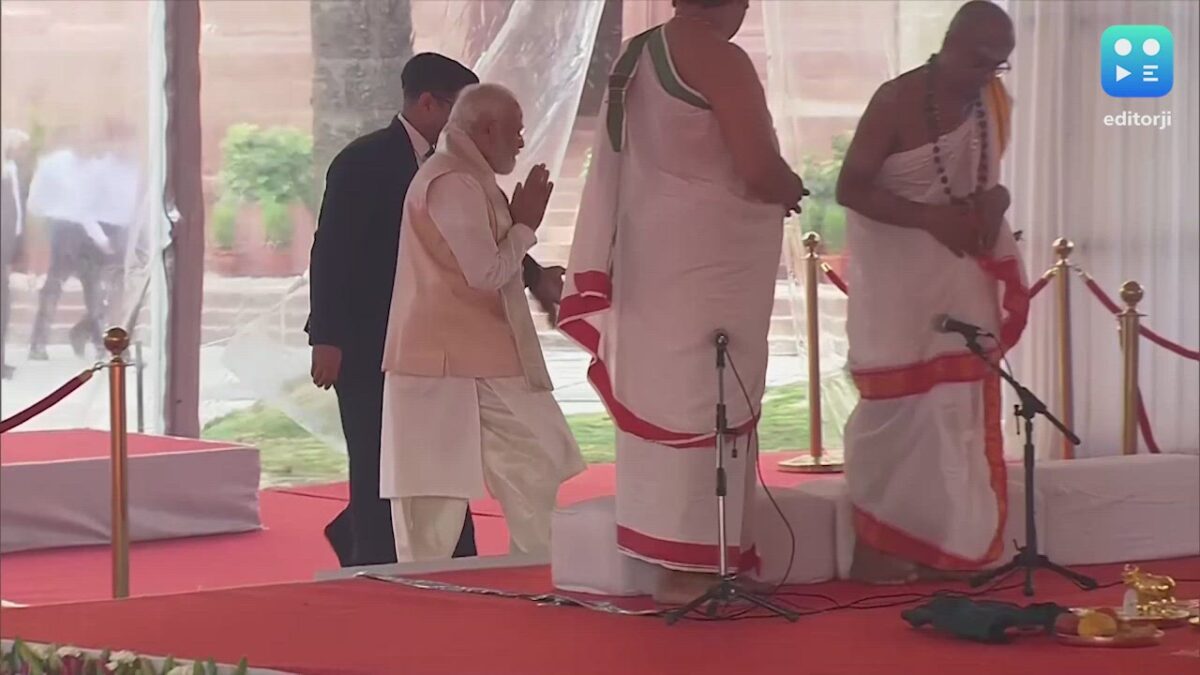The Prime Minister worshiped ‘Ganpati Homan’ to seek blessings and good fortune in the inaugural ceremony of the new Parliament building.

Source: Editorji
With the holy sceptre in hand, Prime Minister Narendra Modi inaugurated the new Parliament building today, receiving blessings from high priests of several ‘adheenams’ in Tamil Nadu. In addition, he placed the antique Sengol in the Lok Sabha chamber. The Sengol was then brought to the new Parliament building in a procession to the music of “nadaswaram” and chanting of Vedic mantras, where it was put in an unusual folding on the right side of the Speaker’s chair in the chamber of Lok Sabha.
The dignitaries present in the ceremony were Rajnath Singh, Amit Shah, S Jaishankar, Ashwini Vaishnaw, Mansukh Mandaviya and Jitendra Singh, Yogi Adityanath, Himanta Biswa Sarma, and BJP president J P Nadda.
Key Features of New Parliament Building
- The new parliament building, built by Tata Projects Ltd, would include a large constitution hall to display India’s democratic legacy, a lounge for MPs, a library, various committee rooms, dining places and enough parking space. The materials for the new structure were sourced from all throughout the country.
- The teakwood used in the making came from Nagpur, Maharashtra, while the red and white sandstone came from Sarmathura, Rajasthan. The sandstone for the national capital’s Red Fort and Humayun’s Tomb was also supplied from Sarmathura.
- The four-story triangular tower is 64,500 square metres in size.
- The three main entrances to the edifice are Gyan Dwar, Shakti Dwar, and Karma Dwar. There are also separate entrances for VIPs, Members of Parliament, and visitors.
- The Kesharia green stone was brought from Udaipur, the red granite from Lakha near Ajmer, and the white marble from Ambaji in Rajasthan.
- “In a sense, the entire country came together to build the temple of democracy, reflecting the true spirit of Ek Bharat Shreshtha Bharat,” an official explained.
- The structure made of steel for the false ceilings of the Lok Sabha and Rajya Sabha chambers were extracted from the union territory of Daman and Diu, while the furniture was produced in Mumbai.
- The stone ‘jaali’ (lattice) works that adorn the structure were sourced from Rajnagar, Rajasthan.
- For the construction of the new Parliament building, manufactured sand, or M-sand, from Charkhi Dadri in Haryana was utilised to create a concrete mix. This sand is considered environmentally benign because it is produced by crushing massive hard stones or granite rather than dredging river beds.
- Bricks of fly ash were sourced from the state of Haryana and Uttar Pradesh, while works of brass and pre-cast trenches were brought all the way from Ahmedabad, Gujarat.
The original structure was found to be insufficient for modern standards over time. Both the Lok Sabha and the Rajya Sabha voted resolutions encouraging the government to establish a new Parliament building.
The new Parliament building can comfortably seat 888 Lok Sabha members and 300 Rajya Sabha members. In the event of a joint sitting of both Houses, the Lok Sabha chamber can hold a total of 1,280 members.

Source: BBC











